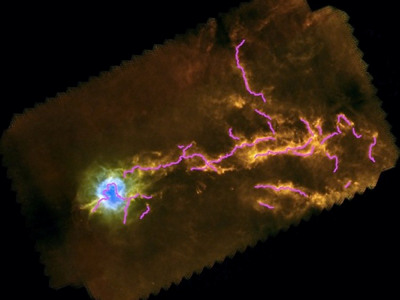Mapping the insterstellar medium

The stellar initial mass function (IMF) is a fundamental global output of the star formation process, and the question of its origin and universality has been a long-standing open issue. While the base of the IMF (∼ solar-type stars) is likely inherited from the prestellar core mass function and may result from gravo-turbulent cloud fragmentation, the problem of how the most extreme stellar objects (high-mass stars and brown dwarfs) build up their masses is completely unsettled. This issue is often tackled through the observations of star-forming regions in dust emission/absorption. However, the physical properties that are inferred form such observations (e.g. mass, temperature) strongly depend on the assumptions made on the dust emissivity, which is known to vary as a function of environment.
NIKA2 and the IRAM 30m telescope together offer the unique opportunity both to constrain dust properties in the millimeter wavelength domain, and to provide answers to questions related to star formation at the extreme ends of the IMF :
Characterizing dust properties
Dust emissivity depends on the dust chemical composition, and size distribution, which are unfortunately poorly constrained. Grain sizes also play an important role in determining the available area for grain surface chemistry and electron recombination, influencing the ionisation fraction and the coupling to the magnetic field. It is expected that dust grains sizes will increase because of coagulation and the formation of ice mantles in dense inner regions. On the other hand, in the outer less dense regions, no ice mantles coat the grains and their optical properties and sizes should differ. By mapping nearby and galactic plane star- forming regions both at 1mm and 2mm with NIKA2 we will be able to constrain variations of the dust emissivity in a broad range of environments.
Probing the origin of the low-mass end of the IMF
Brown dwarfs (BDs), defined as stellar-like objects with masses less than the hydrogen-burning limit MBD = 0.075 M⊙, are now known to be almost as numerous as hydrogen-burning stars, but their formation mechanism remains a matter for debate. The recent identification of a good example of a pre-brown dwarf core in the Ophiuchus protocluster with the IRAM Plateau de Bure interferometer tends to support the idea that BDs form in a similar manner to solar-type stars. It does not yet prove that pre-brown dwarfs are the main channel of brown dwarf formation, however. Performing very sensitive NIKA2 observations of nearby star-forming regions will provide a unique opportunity to take the next step, namely assessing whether pre-brown dwarfs are numerous enough to explain the formation of most observed brown dwarfs.
Characterizing the mass reservoirs of massive star progenitors
Despite the tremendous impact of massive stars on the interstellar medium, no consensus has been reached on the question of their formation. In recent years however, numerical and observational studies have suggested that, as a result of the global collapse of the cloud they form in, massive stars may accrete gas from a much larger mass reservoir than their low-mass counterparts, known to gain mass from their small-scale surrounding core. Characterizing the transition from core-fed to cloud-fed star formation is key for our understanding of the star formation process. NIKA2 observations of a large area of the galactic plane will allow us both to determine what is the frequency and maximum mass of starless dense cores, and to better characterize the variations of the cloud density structure across the core-fed/cloud-fed transition.
Mis à jour le 29 septembre 2023


